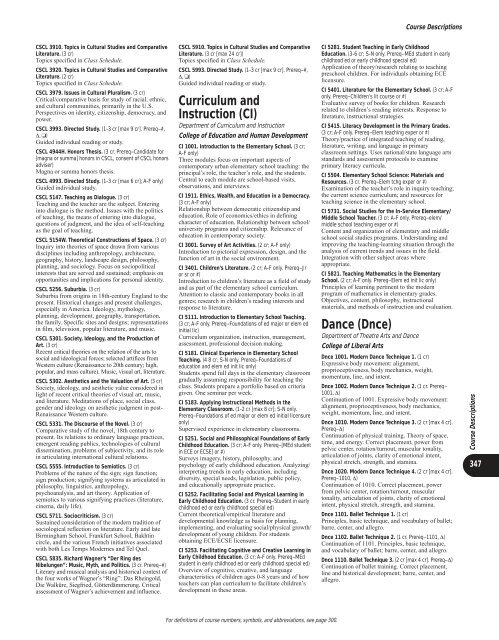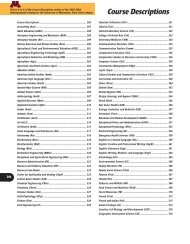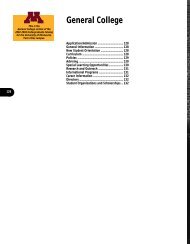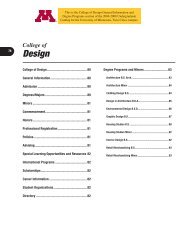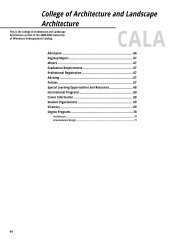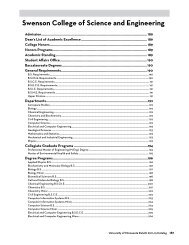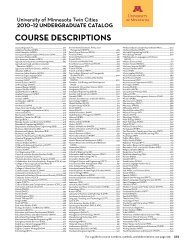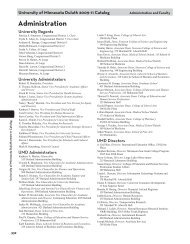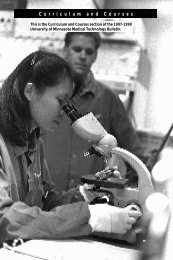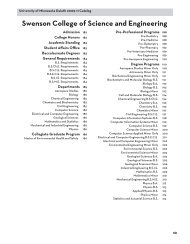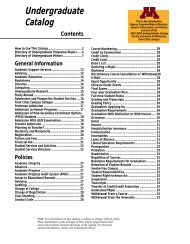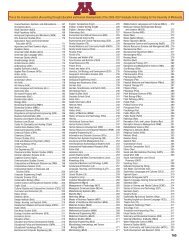CoursesâCSCI through FSCN - University Catalogs - University of ...
CoursesâCSCI through FSCN - University Catalogs - University of ...
CoursesâCSCI through FSCN - University Catalogs - University of ...
You also want an ePaper? Increase the reach of your titles
YUMPU automatically turns print PDFs into web optimized ePapers that Google loves.
Course DescriptionsCSCL 3910. Topics in Cultural Studies and ComparativeLiterature. (3 cr)Topics specified in Class Schedule.CSCL 3920. Topics in Cultural Studies and ComparativeLiterature. (2 cr)Topics specified in Class Schedule.CSCL 3979. Issues in Cultural Pluralism. (3 cr)Critical/comparative basis for study <strong>of</strong> racial, ethnic,and cultural communities, primarily in the U.S.Perspectives on identity, citizenship, democracy, andpower.CSCL 3993. Directed Study. (1-3 cr [max 9 cr]. Prereq–#,∆, ❏)Guided individual reading or study.CSCL 4944H. Honors Thesis. (3 cr. Prereq–Candidate for[magna or summa] honors in CSCL, consent <strong>of</strong> CSCL honorsadviser)Magna or summa honors thesis.CSCL 4993. Directed Study. (1-3 cr [max 6 cr]; A-F only)Guided individual study.CSCL 5147. Teaching as Dialogue. (3 cr)Teaching and the teacher are the subject. Enteringinto dialogue is the method. Issues with the politics<strong>of</strong> teaching, the means <strong>of</strong> entering into dialogue,questions <strong>of</strong> judgment, and the idea <strong>of</strong> self-teachingas the goal <strong>of</strong> teaching.CSCL 5154W. Theoretical Constructions <strong>of</strong> Space. (3 cr)Inquiry into theories <strong>of</strong> space drawn from variousdisciplines including anthropology, architecture,geography, history, landscape design, philosophy,planning, and sociology. Focus on sociopoliticalinterests that are served and sustained; emphasis onopportunities and implications for personal identity.CSCL 5256. Suburbia. (3 cr)Suburbia from origins in 18th-century England to thepresent. Historical changes and present challenges,especially in America. Ideology, mythology,planning, development, geography, transportation,the family. Specific sites and designs; representationsin film, television, popular literature, and music.CSCL 5301. Society, Ideology, and the Production <strong>of</strong>Art. (3 cr)Recent critical theories on the relation <strong>of</strong> the arts tosocial and ideological forces; selected artifices fromWestern culture (Renaissance to 20th century; high,popular, and mass culture). Music, visual art, literature.CSCL 5302. Aesthetics and the Valuation <strong>of</strong> Art. (3 cr)Society, ideology, and aesthetic value considered inlight <strong>of</strong> recent critical theories <strong>of</strong> visual art, music,and literature. Meditations <strong>of</strong> place, social class,gender and ideology on aesthetic judgment in post-Renaissance Western culture.CSCL 5331. The Discourse <strong>of</strong> the Novel. (3 cr)Comparative study <strong>of</strong> the novel, 18th century topresent. Its relations to ordinary language practices,emergent reading publics, technologies <strong>of</strong> culturaldissemination, problems <strong>of</strong> subjectivity, and its rolein articulating international cultural relations.CSCL 5555. Introduction to Semiotics. (3 cr)Problems <strong>of</strong> the nature <strong>of</strong> the sign; sign function;sign production; signifying systems as articulated inphilosophy, linguistics, anthropology,psychoanalysis, and art theory. Application <strong>of</strong>semiotics to various signifying practices (literature,cinema, daily life).CSCL 5711. Sociocriticism. (3 cr)Sustained consideration <strong>of</strong> the modern tradition <strong>of</strong>sociological reflection on literature. Early and lateBirmingham School, Frankfurt School, Bakhtincircle, and the various French initiatives associatedwith both Les Temps Modernes and Tel Quel.CSCL 5835. Richard Wagner’s “Der Ring desNibelungen”: Music, Myth, and Politics. (3 cr. Prereq–#)Literary and musical analysis and historical context <strong>of</strong>the four works <strong>of</strong> Wagner’s “Ring”: Das Rheingold,Die Walküre, Siegfried, Götterdämmerung. Criticalassessment <strong>of</strong> Wagner’s achievement and influence.CSCL 5910. Topics in Cultural Studies and ComparativeLiterature. (3 cr [max 24 cr])Topics specified in Class Schedule.CSCL 5993. Directed Study. (1-3 cr [max 9 cr]. Prereq–#,∆, ❏)Guided individual reading or study.Curriculum andInstruction (CI)Department <strong>of</strong> Curriculum and InstructionCollege <strong>of</strong> Education and Human DevelopmentCI 1001. Introduction to the Elementary School. (3 cr;A-F only)Three modules focus on important aspects <strong>of</strong>contemporary urban elementary school teaching: theprincipal’s role, the teacher’s role, and the students.Central to each module are school-based visits,observations, and interviews.CI 1911. Ethics, Wealth, and Education in a Democracy.(3 cr; A-F only)Relationship between democratic citizenship andeducation. Role <strong>of</strong> economics/ethics in definingcharacter <strong>of</strong> education. Relationship between school/university programs and citizenship. Relevance <strong>of</strong>education in contemporary society.CI 3001. Survey <strong>of</strong> Art Activities. (2 cr; A-F only)Introduction to pictorial expression, design, and thefunction <strong>of</strong> art in the social environment.CI 3401. Children’s Literature. (2 cr; A-F only. Prereq–Jror sr or #)Introduction to children’s literature as a field <strong>of</strong> studyand as part <strong>of</strong> the elementary school curriculum.Attention to classic and contemporary books in allgenres; research in children’s reading interests andresponse to literature.CI 5111. Introduction to Elementary School Teaching.(3 cr; A-F only. Prereq–Foundations <strong>of</strong> ed major or elem edinitial lic)Curriculum organization, instruction, management,assessment, pr<strong>of</strong>essional decision making.CI 5181. Clinical Experience in Elementary SchoolTeaching. (4 8 cr; S-N only. Prereq–Foundations <strong>of</strong>education and elem ed init lic only)Students spend full days in the elementary classroomgradually assuming responsibility for teaching theclass. Students prepare a portfolio based on criteriagiven. One seminar per week.CI 5183. Applying Instructional Methods in theElementary Classroom. (1-2 cr [max 8 cr]; S-N only.Prereq–Foundations <strong>of</strong> ed major or elem ed initial licensureonly)Supervised experience in elementary classrooms.CI 5251. Social and Philosophical Foundations <strong>of</strong> EarlyChildhood Education. (3 cr; A-F only. Prereq–[MEd studentin ECE or ECSE] or #)Surveys imagery, history, philosophy, andpsychology <strong>of</strong> early childhood education. Analyzing/interpreting trends in early education, includingdiversity, special needs, legislation, public policy,and educationally appropriate practice.CI 5252. Facilitating Social and Physical Learning inEarly Childhood Education. (3 cr. Prereq–Student in earlychildhood ed or early childhood special ed)Current theoretical/empirical literature anddevelopmental knowledge as basis for planning,implementing, and evaluating social/physical growth/development <strong>of</strong> young children. For studentsobtaining ECE/ECSE licensure.CI 5253. Facilitating Cognitive and Creative Learning inEarly Childhood Education. (3 cr; A-F only. Prereq–MEdstudent in early childhood ed or early childhood special ed)Overview <strong>of</strong> cognitive, creative, and languagecharacteristics <strong>of</strong> children ages 0-8 years and <strong>of</strong> howteachers can plan curriculum to facilitate children’sdevelopment in these areas.CI 5281. Student Teaching in Early ChildhoodEducation. (3-6 cr; S-N only. Prereq–MEd student in earlychildhood ed or early childhood special ed)Application <strong>of</strong> theory/research relating to teachingpreschool children. For individuals obtaining ECElicensure.CI 5401. Literature for the Elementary School. (3 cr; A-Fonly. Prereq–Children’s lit course or #)Evaluative survey <strong>of</strong> books for children. Researchrelated to children’s reading interests. Response toliterature, instructional strategies.CI 5415. Literacy Development in the Primary Grades.(3 cr; A-F only. Prereq–Elem teaching exper or #)Theory/practice <strong>of</strong> integrated teaching <strong>of</strong> reading,literature, writing, and language in primaryclassroom settings. Uses national/state language artsstandards and assessment protocols to examineprimary literacy curricula.CI 5504. Elementary School Science: Materials andResources. (3 cr. Prereq–Elem tchg exper or #)Examination <strong>of</strong> the teacher’s role in inquiry teaching;the current science curriculum; and resources forteaching science in the elementary school.CI 5731. Social Studies for the In-Service Elementary/Middle School Teacher. (3 cr; A-F only. Prereq–elem/middle school teaching exper or #)Content and organization <strong>of</strong> elementary and middleschool social studies programs. Understanding andimproving the teaching-learning situation <strong>through</strong> theanalysis <strong>of</strong> current trends and issues in the field.Integration with other subject areas whereappropriate.CI 5821. Teaching Mathematics in the ElementarySchool. (2 cr; A-F only. Prereq–Elem ed init lic only)Principles <strong>of</strong> learning pertinent to the modernprogram <strong>of</strong> mathematics in elementary grades.Objectives, content, philosophy, instructionalmaterials, and methods <strong>of</strong> instruction and evaluation.Dance (Dnce)Department <strong>of</strong> Theatre Arts and DanceCollege <strong>of</strong> Liberal ArtsDnce 1001. Modern Dance Technique 1. (1 cr)Expressive body movement: alignment,proprioceptiveness, body mechanics, weight,momentum, line, and intent.Dnce 1002. Modern Dance Technique 2. (1 cr. Prereq–1001, ∆)Continuation <strong>of</strong> 1001. Expressive body movement:alignment, proprioceptiveness, body mechanics,weight, momentum, line, and intent.Dnce 1010. Modern Dance Technique 3. (2 cr [max 4 cr].Prereq–∆)Continuation <strong>of</strong> physical training. Theory <strong>of</strong> space,time, and energy. Correct placement, power frompelvic center, rotation/turnout, muscular tonality,articulation <strong>of</strong> joints, clarity <strong>of</strong> emotional intent,physical stretch, strength, and stamina.Dnce 1020. Modern Dance Technique 4. (2 cr [max 4 cr].Prereq–1010, ∆)Continuation <strong>of</strong> 1010. Correct placement, powerfrom pelvic center, rotation/turnout, musculartonality, articulation <strong>of</strong> joints, clarity <strong>of</strong> emotionalintent, physical stretch, strength, and stamina.Dnce 1101. Ballet Technique 1. (1 cr)Principles, basic technique, and vocabulary <strong>of</strong> ballet;barre, center, and allegro.Dnce 1102. Ballet Technique 2. (1 cr. Prereq–1101, ∆)Continuation <strong>of</strong> 1101. Principles, basic technique,and vocabulary <strong>of</strong> ballet; barre, center, and allegro.Dnce 1110. Ballet Technique 3. (2 cr [max 4 cr]. Prereq–∆)Continuation <strong>of</strong> ballet training. Correct placement,line and historical development; barre, center, andallegro.Course Descriptions347For definitions <strong>of</strong> course numbers, symbols, and abbreviations, see page 300.


